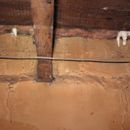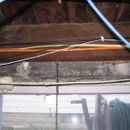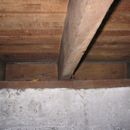Posted previously about problems with concrete block cavities, but I wanted to go ahead and take care of my rim joist. Some stuff I see online is confusing me a bit, however, and was hoping someone might be able to advise. Briefly: Looking to seal/insulate a rim joist in a home built circa the 1920s (Zone 6A) and hopefully eliminate some drafts that have been persisting. At the front of the house, the joist cavities are rather irregular and look to be filled with concrete. Or perhaps it’s the foundation itself. (See first photo.) One half of the back side of the house looks like most of the pictures I see online, with wood cavities. Next to it is a gap for the basement door, then a small “room” under a bathroom where someone stuffed batting against the concrete wall. (Not pictured.)
The sides running parallel to the floor joists consist of a wood band, with old fiberglass batting stuffed in the space between the foundation and the joist. (See third photo.)
My questions:
I understand it’s best to use foil-faced rigid foam so moisture can’t penetrate and collect on the joist, but I’ve also read foil-faced is not good to use against concrete, though I don’t know why. That makes me wonder what kind of rigid foam would be best to use in front of the house. If I purchase typical Owens-Corning 2-inch R-10 foam and double up on it, am I running the risk of moisture problems? Would it be better to use rigid pink foam against the concrete and then add a second layer of foil-faced foam? Or something like Super Tuff-R, which is blue on one side (facing the concrete) and foil-faced on the other, which would face the interior?
Second: Every rim joist article and video I see only illustrates what to do with the cavities. I rarely see discussion of what to do with the band joist running along the left and right sides of the house. It seems like the spray foam guys cover all of it, but it would be hard to cover that area with rigid foam due to the wiring present. I’d also have to tack or glue the boards, since there’s no sill for them to rest on. It would be even harder, I would think, to double up on the layers to achieve R-20. Do I need to cover this area, or can I just try to spray-foam the empty space currently stuffed with batting?
Thanks.












Replies
Hi Tom.
There is no problem using foil-faced rigid foam against concrete (some builders hold the exposed ends of the sheet away from the slab, but even the need to do that is up for debate). That said, you should proceed carefully when insulating those embedded joists. You may want to use a minimal amount of one of the more vapor open types of rigid foam, like EPS. For more information on insulating embedded joists, read this article: Insulating Basement Walls with Embedded Joists.
You can use spray foam on the long running rim joist if that is the simplest option and shouldn't have a problem. However, what this all leads up to is that you'd be better off insulating this all from the exterior. Do you need to upgrade the insulation in the walls above? Is there a siding replacement in your future? If so, perhaps it makes more sense to wait and to add exterior insulation at that point.
Interesting read. Thanks, Brian. Sounds like I'd be best off with 1-inch of EPS foam like R-Tech. But with such low R-value (3.85), I wonder if I wouldn't be better off simply air-sealing and foaming those gaps near the subfloor and then maybe caulking the sides. Using foam with such low insulation abilities and running an increased risk of rot doesn't seem like a favorable trade-off, unless I'm missing something.
Be careful with the R-tech EPS. If you’re thinking of the stuff usually stocked in the box stores, it has a vapor impermeable poly facer. If you want to use EPS because it’s more vapor open than the others, you need to be sure you’re using UNFACED EPS.
You’ll want to both insulate AND air seal your rim joist. Usually you can do both at once since the canned foam normally used to hold the rigid foam insulation in place will also serve to air seal the completed assembly.
Bill
Thanks, Bill., Unfaced EPS is certainly harder to come by. Most varieties I see are faced. Home Depot has a .75 inch variety that's unfaced that might be my best bet short of special-ordering something.
If you have a menards in your area, they stock unfaced EPS. I’m not aware of any other box stores that do. You might check commercial insulation supply houses before special ordering anything, and you see reclaimed insulation places in many areas so look for those too (they often advertise on Craig’s list).
Bill
No Menard's, unfortunately, and they seem to ship every EPS depth except for the 1-inch version. Wondering if I should opt for either the .75 at Home Depot or go for 1.5 inches. I suppose if the idea is to make it more vapor-open, the smaller size would be better. There's some on Amazon listed as being for packing material. I suspect there's no difference between that and what's marketed as insulation. Any thoughts?
I’d with the 1.5” version. If 1” is what you wanted, and listed as a stock item but not shippable while other thicknesses are, I’d call them and ask. Maybe they’ll ship 1” if you ask — it seems odd that everything except for 1” would be shippable.
Bill